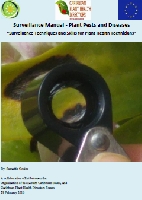
Morne Fortune, Castries, Saint Lucia
Phone: +1 (758) 455-6327
Contact the OECS Commission
External Vacancies
Events
FAQs
OECS Laissez-Passer Certificate
Grievance Redress
Intranet
Subscribe to OECS Newsletter
Google Translate:
Switch Language:

Surveillance Manual - Plant Pest s and Diseases Sumattie Gosine
Chapter 1 Surveillance 1.1 Why do we need to do surveillance?
We need to do surveillance for many reasons; amongst these are the fulfilment of our international obligations as signatories to international treaties and conventions, namely:
The CBD is a global, comprehensive agreement addressing all aspects of biological diversity: genetic resources, species, and ecosystems. Signatories are obligated to uphold Articles 7(c), 8(l), 8(h) and 8(k) of the CBD, with regards to surveillance activities. That is, signatories must:
The IPPC is an international treaty to secure action to: